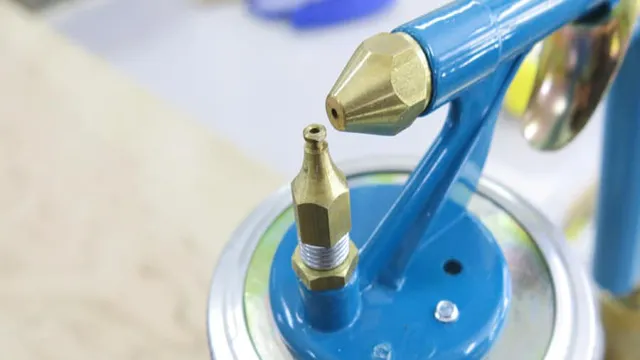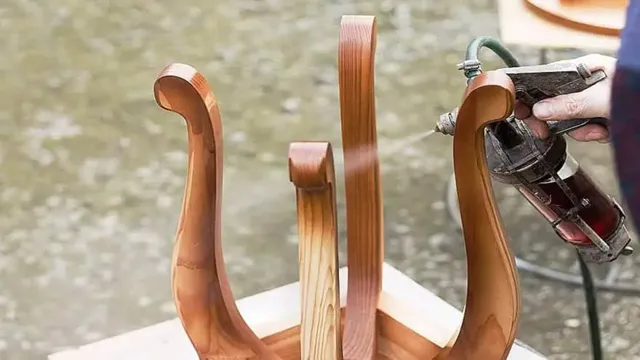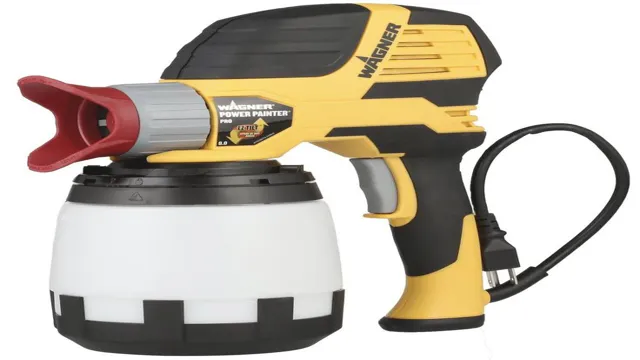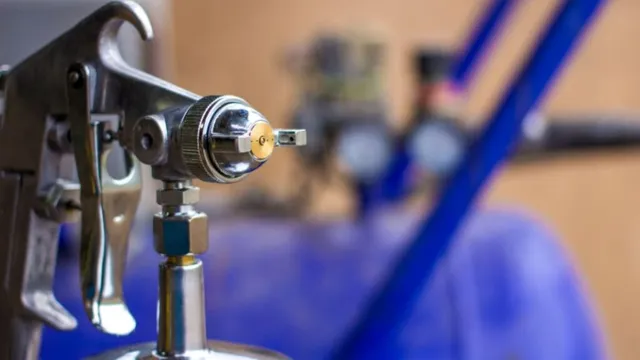Can You Spray Polyurethane with a Paint Sprayer? Tips and Techniques Explored

Do you want a flawless, professional-looking finish for your DIY project? Using a paint sprayer to apply polyurethane might seem like a daunting task, but it’s actually a great option for achieving a smooth and even coat. Whether you’re planning to refinish your cabinets or add a protective layer to your wooden furniture, spraying polyurethane can save you time and effort while providing excellent results. In this blog post, we’ll guide you through the process of spraying polyurethane with a paint sprayer, give you some tips and tricks, and help you avoid common mistakes.
So, grab your paint sprayer and let’s get started!
Polyurethane and Paint Sprayers: A Match Made in Heaven?
If you’re wondering if you can spray polyurethane with a paint sprayer, the answer is a resounding yes! In fact, using a paint sprayer can make applying polyurethane a lot easier and more efficient. With a sprayer, you can achieve a smoother and more even finish, and you can cover large surfaces quickly. However, it’s important to note that not all paint sprayers are created equal.
When spraying polyurethane, you’ll need to use a sprayer that is designed for thick and viscous materials. You’ll also need to ensure that you thin the polyurethane enough to achieve the proper consistency for spraying. With the right sprayer and technique, you can achieve professional-looking results with polyurethane on any surface.
So, if you’re planning a DIY project that involves polyurethane, consider using a paint sprayer to make the process easier and more efficient.
Understanding Polyurethane and Its Properties
Polyurethane Polyurethane is a versatile and durable polymer that has become a popular choice for a wide range of industrial applications, from furniture and automotive upholstery to coatings and adhesives. One of the most unique properties of polyurethane is its ability to resist wear and tear, making it an excellent choice for high-traffic areas that require long-lasting protection. One area where polyurethane has proven to be particularly effective is in the field of paint spraying.
When applied using a paint sprayer, polyurethane forms a smooth, even coating that is resistant to chipping, peeling, and fading. Additionally, polyurethane coatings are much more resistant to environmental factors like UV radiation and moisture, making them an ideal choice for outdoor applications. So, whether you’re looking to protect your wooden furniture or give your car a high-gloss finish, polyurethane and a paint sprayer are a match made in heaven.

Why Use a Paint Sprayer for Polyurethane?
Paint sprayers have become a popular tool for applying polyurethane coatings in recent years, and for good reason. Using a paint sprayer for polyurethane allows for smooth and even coverage, which lends itself to a professional-looking finish. Additionally, a sprayer saves time and effort, especially when working with large surfaces or intricate details where brushing or rolling may be difficult.
The type of polyurethane being used is important to consider when pairing with a sprayer, as some may require thinning before use. However, with the proper equipment and technique, using a paint sprayer for polyurethane can make the process much easier and yield a beautifully coated surface. So, whether you’re a professional contractor or a DIY enthusiast, consider adding a paint sprayer to your arsenal for your next polyurethane project.
Preparing Your Sprayer and Work Area for Polyurethane
Yes, you can use a paint sprayer to apply polyurethane. However, before you start spraying, it’s essential to prepare both your sprayer and work area adequately. Firstly, you’ll need to make sure that your paint sprayer is appropriately cleaned and lubricated.
This will ensure that the sprayer is in good working condition and won’t malfunction when you’re halfway through your project. Secondly, you’ll want to choose the right spray tip for the polyurethane you’re using, as different thicknesses of coating require different nozzle sizes. Once you’ve prepared your sprayer, it’s time to set up your work area.
This should be in a well-ventilated space as polyurethane emits fumes that can be dangerous if inhaled in a confined space. You’ll also want to ensure your work surface is clean and free of chunks or debris that could disrupt the spraying process. Lastly, it’s essential to wear protective gear to prevent the polyurethane from getting on your skin or eyes.
Overall, with the correct preparation, using a paint sprayer to apply polyurethane can save time and effort while providing a beautiful finish.
Choosing the Right Sprayer and Tip Size
When it comes to applying polyurethane, choosing the right sprayer and tip size is crucial for achieving a smooth and even finish. Consider the viscosity of the polyurethane and the size of the area you will be working on to determine which sprayer and tip size will work best for your project. It’s also important to prepare your sprayer by cleaning it thoroughly and ensuring it’s in good working condition.
Your work area should be clean, well-ventilated, and free from any dust or debris that could ruin your finish. Once everything is ready to go, you can begin applying the polyurethane with confidence, knowing that your sprayer and tip size are perfectly suited to the job at hand. By taking the time to properly prepare your sprayer and work area, you’ll ensure a beautiful finish that will last for years to come.
Preparing Your Work Area
When it comes to applying polyurethane, preparing your work area is just as important as prepping your sprayer. The first step is to make sure the surface you’re spraying on is clean and free of debris. Any dust, dirt, or debris can mar the final finish, so make sure to use a tack cloth to remove any loose particles.
Next, ensure that your sprayer is clean and in good condition. That means checking the hoses, nozzles, and spray gun to make sure everything is in working order. Additionally, make sure to wear protective gear like gloves, goggles, and a respirator mask to keep yourself safe during the spray process.
Finally, make sure to set up a proper ventilation system and cover any nearby surfaces that you don’t want to get damaged by overspray. Following these steps will ensure that your work area is safe and clean, and that your polyurethane application goes smoothly without any hiccups.
Mixing and Diluting the Polyurethane
Preparing Your Sprayer and Work Area for Polyurethane requires some attention to detail and safety measures. Begin by ensuring that your sprayer is clean and dry. Make sure to use the right tip size according to the manufacturer’s instructions to obtain the correct pressure and coverage.
Before mixing the polyurethane, it is crucial to protect your work area with a drop cloth or plastic sheet. Moreover, it is essential to wear proper protective gear such as goggles, gloves, and a respirator to prevent inhalation of harmful fumes and skin irritation. It’s recommended to dilute the polyurethane if it’s too thick to achieve the desired consistency.
To avoid any mishaps, always mix the polyurethane thoroughly before pouring it into the sprayer. By adequately preparing your sprayer and work area before spraying polyurethane, you will not only achieve a professional finish but also ensure your safety as well.
Spraying Polyurethane: Tips and Tricks
If you’re wondering whether you can spray polyurethane with a paint sprayer, the answer is yes! In fact, spraying polyurethane is a great way to achieve a smooth and professional finish on your woodworking projects. However, there are a few tips and tricks you should keep in mind to ensure success. First, make sure your sprayer is compatible with polyurethane.
You may need to use a larger tip size than you would with other types of paint. It’s also important to thin the polyurethane appropriately and practice on a test surface before spraying your project. Don’t skimp on protective equipment either- spraying polyurethane can create a lot of fumes, so wear a respirator and work in a well-ventilated area.
With these precautions in mind, you’ll be able to get a beautiful finish that will make your project stand out.
Start with a Test Piece
If you’re new to spraying polyurethane, starting with a test piece is essential to achieving the best results. A test piece is a small sample that you can experiment on before spraying your actual project. This simple step can help you avoid potential problems like uneven coats, runs, or drips.
Before starting, make sure to sand your test piece to the same grit as your project’s surface. Then, apply a thin coat of polyurethane and let it dry completely. Check the finish for any signs of imperfections, and adjust your spray technique or the polyurethane viscosity accordingly.
Remember that spraying polyurethane requires practice, so be patient and don’t rush your test piece. With time and experience, you’ll master the art of spraying polyurethane and achieve a professional-looking finish on your projects.
Practice Your Technique
Polyurethane If you’re looking for a durable finish for your woodworking project, polyurethane is a great choice. Spraying polyurethane can be a bit tricky, but with some practice and the right technique, you can achieve great results. One of the most important things to remember is to use a high-quality spray gun and compressor.
A good spray gun will atomize the polyurethane into tiny droplets, allowing for a smooth and even finish. Another tip is to thin the polyurethane with mineral spirits before spraying to make it easier to apply. It’s also important to wear a respirator and work in a well-ventilated area to avoid health hazards.
Try to move the spray gun in a side-to-side motion, keeping it at a consistent distance from the surface you’re spraying. Start spraying before you reach the surface and continue the motion past the edge to avoid drips. With practice, you’ll be able to achieve an even, glossy finish with polyurethane that will protect your woodworking project for years to come.
Post-Spraying: What to Do Next
If you’re wondering whether you can spray polyurethane with a paint sprayer, the answer is yes, you can. However, there are a few things you need to keep in mind before and after spraying to get the best results possible. First and foremost, make sure you read the manufacturer’s instructions and safety precautions carefully.
Polyurethane is a highly flammable material, so it’s essential to work in a well-ventilated area with proper protective gear. Additionally, because of its quick-drying nature, polyurethane can be challenging to work with and might require multiple coats to achieve a smooth finish. When spraying, hold the gun 6 to 10 inches away from the surface and use a consistent, sweeping motion.
Once you finish spraying, make sure to clean your equipment thoroughly with the appropriate solvents to prevent clogging and extend its lifespan. Overall, spraying polyurethane with a paint sprayer can be a time-efficient and cost-effective method if you take the necessary precautions and follow the recommended techniques.
Conclusion
In conclusion, if you’re wondering whether you can spray polyurethane with a paint sprayer, the answer is a resounding yes. Just make sure to choose the right type of sprayer and follow the manufacturer’s instructions carefully. After all, as they say, when it comes to spraying polyurethane, it’s all about the sprayer, not the player.
So go forth and spray with confidence, knowing that your finish will be smooth and flawless.”
FAQs
What is polyurethane spray and what is it used for?
Polyurethane spray is a type of finishing spray used to protect and preserve wood surfaces. It is commonly used on floors, cabinets, and furniture to provide a durable and long-lasting finish.
Can you spray polyurethane with a paint sprayer?
Yes, you can spray polyurethane with a paint sprayer. However, it is important to use the right type of sprayer and equipment to ensure a smooth and consistent finish. It is also recommended to practice on a small test area before using it on the final project.
What type of paint sprayer is best for spraying polyurethane?
Airless paint sprayers are the best choice for spraying polyurethane, as they provide a consistent and even coverage. HVLP (high-volume, low-pressure) sprayers can also be used, but may require more thinning of the polyurethane.
How do you thin polyurethane for spraying?
Polyurethane can be thinned by adding mineral spirits or turpentine in small amounts until the desired consistency is reached. It is important to follow the manufacturer’s instructions for the specific product being used.
How long does polyurethane take to dry after spraying?
The drying time for polyurethane can vary depending on the temperature, humidity, and thickness of the coating. Generally, it takes 24-48 hours for polyurethane to dry after spraying.
How many coats of polyurethane should be applied when spraying?
It is recommended to apply at least two coats of polyurethane when spraying, allowing each coat to dry completely before applying the next coat. Additional coats may be applied for added protection and durability.
Can polyurethane be sprayed over paint?
Yes, polyurethane can be sprayed over paint. However, it is important to ensure the paint is completely dry and cured before applying the polyurethane. It is also recommended to sand the painted surface lightly before spraying the polyurethane.



